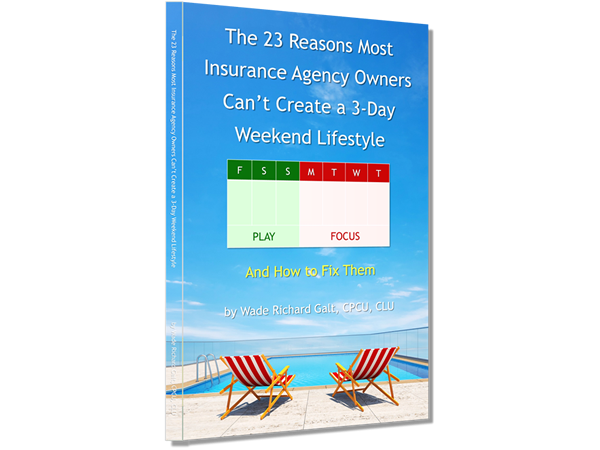8. Retention - Step 5 to Create an Automatic Insurance Agency
Minimize customer defection & policy lapses... maximize retention rate... multiply renewal income.
Quick Summary
-
The lapse rate is highlighted as a key metric that can make a substantial difference in agency income, and efforts should be made to reduce it.
-
Focus on minimizing lapse rates and maximizing client retention to ensure continued income and growth for the agency.
-
Building deeper relationships with clients is emphasized as a strategy to reduce lapse rates.
-
Regular contact, discount reviews, income protection plan reviews, and coverage optimization reviews are recommended as ways to connect with clients and provide valuable assistance.
-
It is advised to prioritize improving retention rates before scaling the business, ensuring a solid foundation before expanding further.
Full (Edited) Transcript
Retention - Step 5 to Create an Automatic Insurance Agency
As we go deeper into this, you're probably starting to get familiar. We have our vision. We have our role clarity, and we know how we want to compensate people, and we want to hold them accountable. Now that we have the framework of our purpose and how we're going to execute that, we want to go into what we're going to do to make real things happen, to make sure that the clients are being retained, that we're selling stuff. And so in our retention area, we want to make sure that we're minimizing our lapse rate.
In other words, maximizing our retention and multiplying our renewal income. Now, I'm going to use an example here to paint a picture and show you what this can look like. And what I'm going to do is use an example of an agency that has 300,000 of renewal commissions. They have a new sales rate. And what we're going to do is look at what would happen over 20 years based on some assumptions.
So if we look at a client lapse rate now, some of you all are used to looking at a lapse rate. Some of you are looking at a retention rate. I like using lapse rate because of the math. So for example, we jump down here where it says lapse rate. I want you to think about this for a second.
If you turn over 10% of your business every year, that means, on average, after ten years, you'll turn over your entire book of business. So 10% lapse rate means a ten year client. So that is not the only thing we're looking at, but it's the interaction of the lapse rate with our new sales rate that gives us our gain rate. So here if we've got a lapse rate of 16% and a gain rate of 16%, we're at zero.
So here, if we have a lapse rate of and a new sales rate of 16%, our gain rate is zero. And I know there's some exponential math in there somewhere. I'm going to keep things simple just to use some simple math here. And so let's say we have this 300,000 of P&C renewal commissions based on our gain rate. In essence, it's really our gain rate that's at play here.
But after a while, it gets to be difficult to maintain a 20 30% new sales rate. So lapse rate, of course, becomes important. And even if you can sell at 20-30%, why wouldn't you minimize your lapses to make more money? So if we look at our gain rate at a 1% gain rate over a ten year period, the agency would average 33,000 more in P&C renewal commissions. At a 2% difference, it'd be 71,000 more per year.
So each of these numbers are per year. So if we could make a 5% lapse rate difference, that would be 220,000 more per year average over a 20 year period. And so when you multiply those numbers times 20, because this is where we sort of back into these numbers. You see what a big difference it makes. Because, again, if we have a 0% gain rate when we continue making 300,000 for 20 years, that's 6 million.
That's good. But overall, each of lapse rate makes a big difference in the total agency income. And so what this means to you is, let's say you normally take home a certain percentage and you know that percentage. So you might regularly take home 20% or 30 or 40% of your agency grows. You're not going to get to keep all of this because somebody's going to have to service it and make sure it renews.
But if you can go from this 0% gain rate to this gain rate and your agency can go from grossing 300,000 to 464,000, that's another 164,000 per year average over these 20 years. Of course, more of it will come later. And in fact, the longer you go with us, the numbers get even bigger, just like any other investment that compounds more as you go further on in years. But basically you have 164,000 more. And whatever your percentage you make is if you make a quarter of that, well, that's 40,000.
If you make 50% of that, that's another 800 per year based off of you simply making sure your team is mining their lapse rate. And so when we look at it from a graphical standpoint, we see what a big difference this defection rate of this lapse rate means to be able to keep it down. Now, most people I talk with are usually aiming for a lapse rate or a retention rate. And sometimes retention rate can sound pretty good, as opposed to 90 or 88 or 87 doesn't sound that big of a deal.
That's kind of why I like to focus on lapse rate numbers, because 15% is clearly a lot different than.
And so, again, everything else in your agency is going to be impacted by this. This is the biggest income source for most agencies. Once you go past three to five years, even if you write a lot of life and annuity business, then even if that's 40 or 50% of your income, this is the automatic income. This is the income that happens for the most part by your team members managing it rather than you having to be involved. And so getting this right really sets you up to where you have your agency, at least income wise, as automatic as possible.
And it doesn't require you to constantly be involved in every day to day transaction. Now, if you want to reduce your lapse right, we find the best way to do that is to build deeper relationships with your clients. One of the simplest way to do that is to have regular contact with your clients, either by phone or text or email. We like to start out with quarterly calls, and the first call is a very simple call. We call it to how may I help you?
Call? We just check in with the client to see if everything's good. There's no pivot. There's nothing else to it. Just making sure the clients good and building that report to let them know we're looking out for them.
We're distinguishing ourselves from the call centers and the online insurance companies and making sure they know we're there to help them if they need anything. The second thing we do is to call and offer a discount review, make sure that all of their discounts are up to date, that they're not paying for any duplicate coverages, that they're getting what they want and not paying for anything more. The third thing we will offer an income protection plan review, make sure their paycheck is protected, that relates to disability insurance and life insurance, and make sure they're aware of what they can do to protect their family themselves if they're unable to work.
And then the coverage optimization review is an offering to help them look at all of their investments in insurance, their entire portfolio, and see, are they getting the most coverage for their dollar? Are they gaining what they need?
It's really a full blown multiline review. And so in each of these calls were relationship building. The first call is, hey, is there anything I can do to help? Second is, Are you getting all your discounts? Third is, what kind of income protection plan do you have in place?
And fourth is, Are you getting the best coverage for the best price? All of these are areas where we're willing to serve the clients and at the very least, connect with them. So even if we don't end up doing something for them, they know we've called out to reach out to them. We're willing to serve them. If they say they'd rather be contacted by text or email, we'll make those adjustments, but we're making sure that we build that relationship and let them know we're here to help them and let them know that before they decide to go anywhere else, they're already being taken care of really well, even if they consider going somewhere else to come to us.
First, once we get our retention numbers tight, then it makes sense to scale and try to bring in more business. So we don't want to have a hole in the boat. We don't want to have poor retention and then just add a bigger engine to the boat. We want to tighten up as many of the holes as possible. Then we'll scale the business, and we'll look at that in the next video.
As always, afford to helping you help more people and make more money in less time. Do what you do best so you can better enjoy your family, your friends, and your life. Thanks for listening.
Get the eBook

Start Working Less & Making More
At least 5 of these obstacles are hurting your Production, and Income, Freedom. Start fixing them now!
We won't send spam you. Unsubscribe at any time.
eBook will be emailed to you.Schedule a Strategy Session
We’ll Discuss Your
- Biggest Goal - If you or your agency could only achieve 1 thing in the next 12 months, what would it be?
- Value of Biggest Goal - What's it worth to you (money, free time and / or happiness) to achieve this goal?
- Biggest Frustration - If you could "fix" 1 thing in your agency in the next 12 months, what would it be?
- Frustration Cost - What is your biggest frustration COSTING you (money, free time and / or happiness)?
Then, We’ll Discuss the Plan & Expected Results
- Which goal(s) are likely to be achieved and how long it usually takes, based on our experience.
- The best way to help you achieve your goals, based on your style and time available to implement.
- Your anticipated time investments & money investments.
- What guarantees we can make









